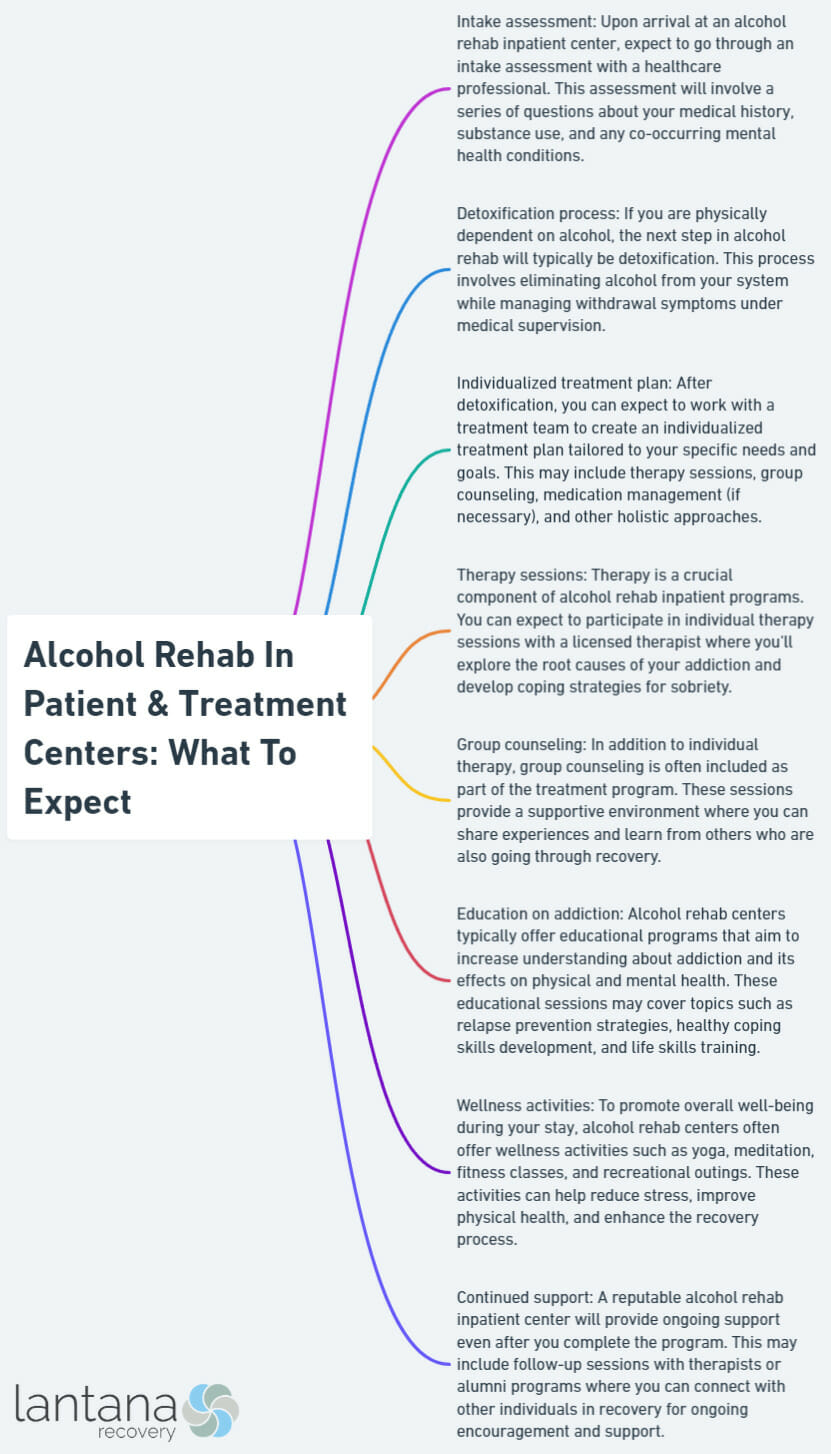Taking the first step towards recovery from alcohol addiction can be daunting, especially when faced with the numerous treatment options available. Alcohol rehab in patients, an intensive and comprehensive approach to treatment, has helped countless individuals overcome addiction and achieve long-term sobriety. In this blog post, we’ll dive deep into the world of inpatient alcohol rehab, discussing its various aspects, benefits, and how to choose the right program for you or your loved one. By understanding the intricacies of alcohol rehab in patients, you’ll be better equipped to make informed decisions and embark on the path to a healthier, alcohol-free life.
Key Takeaways
- Inpatient alcohol rehab offers comprehensive treatment, medical supervision and a supportive environment for successful recovery.
- Different types of inpatient programs are tailored to meet the needs of specific populations, with lengths ranging from 30 days to 90 days.
- Aftercare services such as outpatient therapy and support groups provide continued assistance for long-term sobriety with family involvement being essential.
Understanding Inpatient Alcohol Rehab

Inpatient alcohol rehab provides comprehensive alcohol treatment in a controlled setting, offering 24-hour access to medical personnel and tailored therapies for individuals battling alcohol addiction. This type of treatment sets itself apart from outpatient treatment programs, as patients reside at the facility during the entire course of their treatment. Inpatient rehab has been proven effective in treating even the most severe cases of alcohol addiction, with the Substance Abuse and Mental Health Services Administration (SAMHSA) recognizing it as a vital component of addiction treatment.
The benefits of inpatient rehab are numerous, including:
- A structured environment
- Constant support
- Medical supervision
- A higher success rate for long-term sobriety
These advantages make it an ideal choice for individuals in need of intensive treatment and ongoing care.
We shall now explore the inpatient treatment process, discuss various types of inpatient rehab programs and examine the factors affecting the duration and cost of treatment.
The Inpatient Treatment Process
The start of the inpatient treatment process for drug abuse involves detailed medical screening and medical detox. During this stage, physicians take into account factors like existing mental health issues, past withdrawal seizures and other complications like delirium. Inpatient detox may be the most suitable level of care for individuals at risk of severe alcohol withdrawal symptoms, as it provides 24-hour care and access to potentially life-saving medical interventions.
Medication-assisted treatment (MAT) plays an integral role in inpatient alcohol rehab, assisting patients in ceasing their drug and alcohol use and remaining abstinent through a combination of medications and behavioral therapy. Personalized treatment plans are crucial to the success of inpatient rehab programs, as they incorporate a variety of therapeutic interventions tailored to address the patient’s individual needs. These interventions can encompass individual and group therapy sessions, including 12-step meetings, and experiential therapies such as music therapy, art therapy, and equine therapy.
A typical day in inpatient addiction treatment consists of:
- A schedule packed with treatment activities, appointments, and services designed to fulfill the individual’s recovery needs and objectives
- A structured environment that ensures patients remain focused on their recovery
- Support and care to help patients progress towards long-term sobriety
Benefits of Inpatient Rehab
The advantages of inpatient rehabilitation include:
- Comprehensive treatment provided within the facility
- A structured setting that helps patients establish a daily routine and minimize distractions and triggers
- 24-hour access to medical professionals for necessary care and support throughout the recovery journey.
Long-term sobriety is more likely to be achieved through inpatient rehab, as patients are given the tools and resources needed to address the root causes of their addiction and develop healthy coping mechanisms. A research conducted at Temple University, Philadelphia reported that residential treatment programs have a higher success rate (65%) than outpatient addiction treatment programs (52%).
In comparison to other forms of treatment, inpatient rehab provides an environment where patients can focus solely on their recovery, surrounded by a supportive community of professionals and peers who understand the challenges of overcoming addiction.
Types of Inpatient Alcohol Rehab Programs

Inpatient alcohol rehab programs can be broadly categorized into three main types: residential treatment centers, partial hospitalization programs, and specialized facilities. Each type of program offers distinct advantages and caters to different needs, making it crucial to understand their characteristics when selecting the most suitable treatment option for yourself or a loved one.
The level of care and structure provided by residential treatment centers and partial hospitalization programs are different. While residential treatment centers offer 24-hour care in a non-hospital setting, partial hospitalization programs provide intensive treatment for several hours a day, allowing patients to return home or to a sober living facility at night.
Specialized facilities, on the other hand, cater to specific populations, such as gender-specific programs, dual diagnosis treatment, and programs for adolescents or older adults.
Residential Treatment Centers
Residential treatment centers provide:
- 24-hour care in a non-hospital setting
- Individualized treatment plans
- Various therapy options
- A structured and supportive environment
- Staff members dedicated to helping patients achieve their recovery goals.
In addition to traditional therapy options, residential treatment centers may also offer alternative therapies such as art therapy, music therapy, or equine therapy, providing patients with a well-rounded approach to treatment.
The advantages of residential rehabs for drug addicts include constant access to care and a wide range of therapies tailored to address the individual’s unique needs and challenges. This comprehensive approach to treatment ensures that patients receive the support and resources necessary to overcome addiction and achieve long-term sobriety.
Partial Hospitalization Programs
Partial hospitalization programs (PHPs) offer intensive treatment for several hours a day while allowing patients to return home or to a sober living facility at night. This type of program is most beneficial for individuals who have a stable home environment and are located in close proximity to the treatment facility. PHPs typically run daily and last between six to eight hours, providing patients with a balance between the intensity of inpatient treatment and the flexibility of outpatient care.
PHPs are an excellent option for individuals who require a high level of care but do not need the round-the-clock supervision provided by residential treatment centers. By offering intensive treatment in a structured environment, PHPs help patients build the skills and habits necessary for maintaining sobriety outside of the treatment facility.
Specialized Facilities
Specialized facilities cater to specific populations and provide tailored programs and services designed to address the unique needs of the individuals or groups they serve. These facilities may focus on:
- Gender-specific programs
- Dual diagnosis treatment
- Programs for adolescents
- Programs for older adults
This ensures that patients receive the appropriate care and support needed for their specific circumstances.
The benefits of specialized facilities include:
- A more comfortable and supportive atmosphere for individuals in recovery
- The availability of specialized equipment
- Trained staff
- Tailored programs that are designed to help individuals reach their recovery goals
By addressing the specific needs and challenges of each patient, specialized facilities can play a crucial role in the success of an individual’s recovery journey.
Duration of Inpatient Alcohol Rehab

Several factors influence the duration of inpatient alcohol rehab, including the severity of addiction, individual requirements, and the existence of co-occurring disorders. Inpatient alcohol rehabilitation typically consists of 30, 60, and 90-day programs, with the length of stay contingent upon a range of considerations. Generally, longer programs tend to produce more favorable results, as they provide patients with ample time to address the root causes of their addiction and develop the skills necessary to maintain sobriety.
Keep in mind that everyone’s recovery journey is distinct. The suitable length of treatment hinges on factors like addiction intensity, the person’s progress in treatment, and the availability of aftercare services. By working closely with treatment professionals, patients can determine the most suitable length of stay for their specific needs and circumstances.
Factors Affecting Length of Stay
There are several factors that can affect the length of stay in inpatient rehab. These include the patient’s age, past substance use, and any existing mental health issues. Prolonged alcohol consumption can alter the brain’s functioning and have a detrimental impact on other vital organs, including the heart, lungs, and liver. As such, it is necessary for the body to be given time to return to a healthy state following cessation of drinking.
Other factors that may influence the length of stay include the severity of the patient’s addiction and the presence of any co-occurring disorders. By taking these factors into account, treatment professionals can develop a tailored plan that provides the appropriate level of care and support for each individual’s unique needs.
Long-Term vs. Short-Term Programs
Long-term inpatient alcohol rehab programs usually extend for 90 days or longer, whereas short-term programs might span 30 to 60 days, contingent on the patient’s requirements and progress. Research by Steven Proctor from Louisiana State University suggests that normally longer courses of treatment leads to desirable outcomes, as they provide patients with ample time to address the root causes of their addiction and develop healthy coping mechanisms.
When choosing between long-term and short-term programs, it’s important to consider the individual’s specific circumstances and needs. Factors such as the severity of addiction, the presence of co-occurring disorders, and the individual’s progress in treatment should all be taken into account when determining the most appropriate duration of inpatient rehab.
Cost and Insurance Coverage for Inpatient Alcohol Rehab

The cost of inpatient alcohol addiction treatment rehab can vary based on factors such as:
- The treatment center
- Length of stay
- Level of care
- Facility’s location
- Amenities
- Therapies available
- Reputation and accreditation of the facility
All of these factors may be taken into consideration when determining the cost of treatment.
While the cost of inpatient rehab may be a concern for some individuals, it’s important to remember that insurance coverage often helps reduce out-of-pocket expenses. Insurance coverage for inpatient rehab varies depending on the individual’s policy, with many plans covering at least a portion of the treatment costs. By working closely with treatment professionals and insurance providers, patients can determine the extent of their coverage and explore options for reducing the financial burden associated with inpatient rehab.
Factors Affecting Cost
Several factors can influence the cost of inpatient alcohol rehab, including:
- The location of the facility
- The duration of the program
- The amenities and services provided
- The level of medical care required
The facility’s location, for example, can influence the cost of treatment, as certain areas may incur higher expenses for living and services. The inpatient alcohol rehab in South Carolina might cost differently than an inpatient rehab for alcohol in Georgia
Additionally, the duration of the program can have a bearing on the costs, as longer programs may necessitate additional resources and personnel. Amenities and services provided can also impact the cost of inpatient alcohol rehab, as certain facilities may provide more luxurious amenities and services that can consequently increase the cost.
Lastly, the level of medical care necessary may influence the cost of treatment, as certain medical treatments may be more costly than others. By considering these factors, individuals can better understand and plan for the costs associated with inpatient rehab.
Insurance Coverage

Insurance coverage for inpatient alcohol rehab varies depending on the individual’s policy, with many plans providing coverage for a portion of the treatment expenses. To determine if your insurance is in-network at one of the rehab facilities, it’s important to confirm the details with your insurance provider and the treatment center.
Insuring yourself can greatly reduce, if not completely remove, the expenses associated with rehabilitation. Such security will provide great financial relief when it matters most. By working closely with the treatment provider and your insurance company, you can determine the extent of your coverage and explore options for minimizing the financial burden associated with inpatient alcohol rehab.
Choosing the Right Inpatient Alcohol Rehab Center

Selecting the appropriate inpatient alcohol rehab center is a vital decision that can significantly influence the success of a person’s recovery journey. To make an informed choice, it’s important to consider factors such as:
- The facility’s location
- Treatment approach
- Staff credentials
- Available amenities
Additionally, the duration of inpatient alcohol rehab, as well as the costs and insurance coverage, should be taken into account when selecting the most suitable treatment option.
By evaluating these factors and asking the right questions, you can ensure that you or your loved one receives the appropriate level of care and support needed for a successful recovery. In the following sections, we will explore important factors to consider and questions to ask when evaluating inpatient alcohol rehab centers.
Important Factors to Consider
When choosing an inpatient rehab center, one should consider the patient’s specific needs, which include medical history, mental health, and any other underlying conditions. Additionally, the success rate of the facility is an important factor to consider, as it can provide insight into the effectiveness of the treatment approach and the likelihood of long-term sobriety.
Another key aspect to consider is the availability of specialized programs that may include detoxification, counseling, and other therapies tailored to the individual’s needs. By addressing these factors, you can ensure that the chosen inpatient alcohol rehab center offers the appropriate level of care and support needed for a successful recovery.
Questions to Ask
As you evaluate inpatient rehab centers, make sure to ask questions that allow you to better understand elements like:
- The facility’s licensing
- The treatment approach
- Staff qualifications
- Aftercare planning
Inquiring about the facility’s licensing can provide insight into the credibility and professionalism of the treatment center, while questions about the treatment approach can help you determine if the facility’s methods align with the specific needs of the individual seeking treatment.
Additionally, asking about the qualifications of the facility’s staff can reassure you that the professionals providing care are experienced and well-trained in their respective fields.
Lastly, inquiring about the facility’s aftercare planning is vital, as it can help ensure that the individual receives the necessary support and resources to maintain sobriety and reintegrate into their community following the completion of inpatient rehab.
Aftercare and Ongoing Support

Aftercare and continuous support form essential components of long-term recovery. They equip individuals with the vital resources needed to maintain sobriety and reintegrate into their communities, especially for those dealing with co-occurring mental health issues. The Substance Abuse and Mental Health Services Administration (SAMHSA) outlines the importance of aftercare in the substance abuse treatment process, emphasizing the need for continued support and assistance following the completion of inpatient rehab.
“Active aftercare in general maintained short-term favorable effects by reducing relapse in youth with AUD and should be considered as part of standard procedures in therapeutic interventions for all alcohol and other substance use,” recommends a randomized control trial to study the importance of aftercare support for adolescents with alcohol use disorders. (Twelve-month follow-up of aftercare for adolescents with alcohol use disorders, Burleson et al., 2011)
Various services are available to help individuals maintain their sobriety and navigate the challenges of life after rehab, such as:
- Outpatient therapy
- Support groups
- Sober living facilities
- Ongoing case management
By engaging in these aftercare services and maintaining a strong support system, individuals can greatly increase their chances of achieving long-term sobriety and leading fulfilling, alcohol-free lives.
Types of Aftercare Services
Outpatient therapy, support groups, sober living facilities, and ongoing case management are just some of the aftercare services available to individuals who have completed inpatient alcohol rehab.
Outpatient therapy offers ongoing inpatient and outpatient treatment services, including a comprehensive treatment program with:
- therapy
- outpatient treatment
- 12-step groups
- support programs
These services aim to provide continued support and help individuals maintain their sobriety.
Support groups provide a safe and encouraging environment for individuals to discuss their experiences and challenges related to drug addiction, offering guidance and assistance to maintain sobriety.
Sober living facilities and ongoing case management services provide additional support, helping individuals navigate the challenges of life after rehab and maintain their sobriety.
The Role of Family and Friends
Family and friends play a crucial role in aftercare, offering emotional support, encouragement, and accountability throughout the recovery process. Family members can be actively engaged in the treatment process by participating in scheduled visits, family classes, and family therapy, providing motivation to individuals with alcohol use disorder to pursue treatment and foster positive changes in their drinking habits.
Having a robust support system greatly increases the likelihood of successful recovery. By involving family and friends in aftercare, individuals can create a nurturing environment that fosters growth, healing, and long-term sobriety.

Summary
In conclusion, understanding the various aspects of inpatient alcohol rehab is vital for making informed decisions about addiction treatment and embarking on the path to a healthier, alcohol-free life. By exploring the inpatient treatment process, types of rehab programs, duration and cost of treatment, and the importance of aftercare and ongoing support, individuals and their families can navigate the complex world of addiction treatment with confidence.
As you or your loved one embark on the journey towards recovery, remember that the right treatment program, coupled with a strong support system and commitment to sobriety, can make all the difference in achieving long-term success. The road to recovery may be challenging, but with the right tools and resources, a fulfilling and alcohol-free life is possible.
Frequently Asked Questions
What are the 4 treatments for alcoholism?
Four common treatments for alcoholism are Cognitive Behavioral Therapy, Interventions, Motivational Enhancement Therapy and Medication Management. Each treatment focuses on different aspects of the disease to help those struggling with addiction.
Cognitive Behavioral Therapy (CBT) is a type of psychotherapy that helps people identify and change negative thinking and behavior patterns. It focuses on helping people recognize and modify their thoughts and behaviors that contribute to their success.
What are the five steps to rehab?
Rehab typically involves five stages: detoxification, stabilization, rehabilitation, relapse prevention, and recovery maintenance.
To ensure successful treatment, it is important to go through each stage gradually and with a professional’s guidance.
What is the rehab phase of recovery?
The rehab phase of recovery is composed of four main steps: controlling pain and swelling, improving range of motion and flexibility, building strength, and finally proprioception and balance training with sport-specific exercises.
Controlling pain and swelling is the first step in the rehab process. This can be done through the use of medications, ice, and rest. Improving range of motion and flexibility is the second step. This can be done through stretching, massage, and other manual therapies. Building strength is the key.
What types of therapies are available in inpatient alcohol rehab?
Inpatient alcohol rehab offers a range of therapeutic options, including individual and group therapies such as 12-step meetings and experiential therapies like music therapy, art therapy, or equine therapy.
These therapies are designed to help individuals struggling with alcohol addiction gain insight into their addiction, develop coping skills, and learn how to live a healthier, more balanced life.
Inpatient alcohol rehab programs also provide medical care and medication management to help individuals manage withdrawal symptoms and c.
What is the difference between residential treatment centers and partial hospitalization programs?
Residential treatment centers offer 24-hour care and emphasize individualized treatment plans, while partial hospitalization programs provide intensive treatment for several hours each day and allow patients to return home at night.









